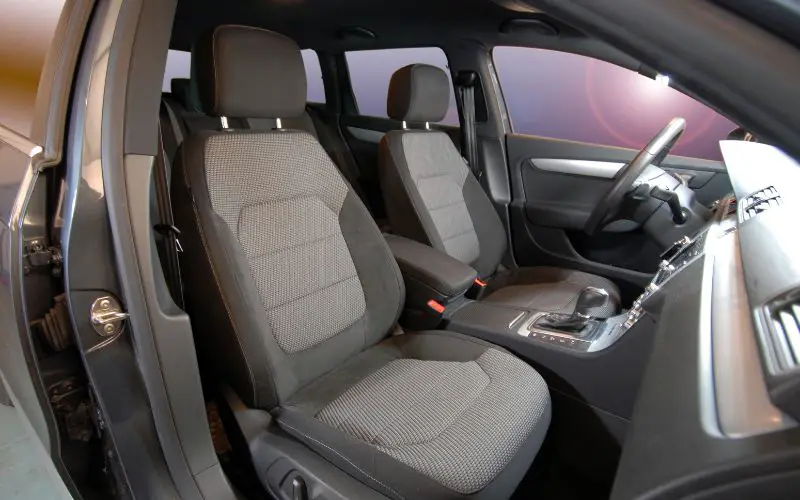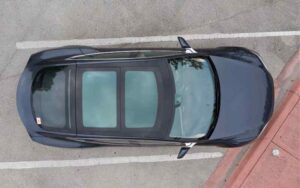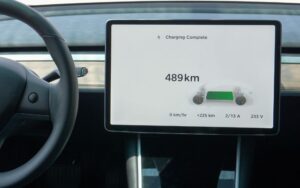Tesla Front Passenger Safety Restraint System Fault!
Last updated on April 18th, 2023 at 11:18 pm
A vital feature of Tesla vehicles is error messages indicating issues with one or more car components. One of these signals is the front passenger safety restraint system fault.
Knowing the implications of this notification will help you avert possible dangers to the occupants of your Tesla vehicle. Let’s go over the front passenger safety restraint system fault.
The front passenger safety restraint system fault indicates malfunctioning of the safety restraint system in Tesla vehicles. The issue could be from the seatbelts or airbags, which are the system’s main components.
Common Front Passenger Safety Restraint System Faults

Various issues can let off a Tesla car’s front passenger safety restraint system fault. However, the common ones are from the seatbelt and other associated parts.
A safety restraint fault may be the inability of the vehicle to detect if the seatbelt is in use. This problem arises from a misaligned or disconnected seatbelt sensor.
It could also be due to faults in other components of the wiring harness under the seat. For instance, an unplugged controller will trigger the safety restraint system fault.
Loosed connectors and disconnected wires in the wiring harness are also possible reasons for undetected seatbelt use in Tesla vehicles.
Another common trigger for the front passenger safety restraint system fault is a seat load. The vehicle may read heavy objects on its seat as passengers without a seatbelt and signal.
Furthermore, a wet front passenger seat is a common safety restraint system fault.
Spilling water or other liquids on the seat can make the vehicle signal the safety restraint system fault message.
A rear-facing child restraint system breaches Tesla’s front passenger seat terms. Seating a child in such a system in the front passenger seat is a front passenger safety restraint system fault.
Practices that may interfere with the smooth deployment of airbags are also common safety restraint faults. One of these is passengers placing their arms over airbag modules.
Some Tesla models do not allow seat covers as they restrict the deployment of seat-mounted side airbags. A breach of this term translates to a safety restraint system fault.
You can get the front passenger safety restraint system fault alert due to a recent update in the vehicle’s software. In this case, it may be an over–air issue and not your car’s fault.
How Much Does It Cost To Fix Front Passenger Safety Restraint Faults?
The cost of fixing a front passenger safety restraint fault depends on the affected part. The cost of repair or replacement increases with an increase in the extent of the issue.
Replacing a seat or airbag can cost as much as $2,000. Repairs or changes to smaller components will cost less.
If you encounter a safety restraint fault that you can’t fix yourself, contact a Tesla service center. You will get a precise cost for fixing the problem.
Fixing a safety restraint system fault for a vehicle under warranty is free. If you have not exceeded the factory insurance limit, Tesla will fix the faults at no cost.
How To Fix Safety Restraint System Faults?
Some of the safety restraint system faults are minor issues in the vehicle components.
Hence, you can set them right using the simple troubleshooting steps given below:
#1. Move the Front Passenger Seat
Moving the affected seat is one way to fix the fault of the front passenger safety restraint system. This method will work if the issue is from a clamped wire or a connector.
Move the seat forward and backward and check if the error message is still there. If it isn’t, you resolved the issue. If it is, move on to other fixes.
#2. Dry Wet Seat
You know that water spills on the front passenger seat can prompt safety restraint system faults. So, if you have this issue because of a wet seat, try drying it.
You can dry a wet seat using a hair dryer. Alternatively, turn on the seat seater to get rid of the wetness in the seats.
Use the steps below to turn on the heater if you don’t know how to do so:
- Click on the temperature at the bottom of the touchscreen to access the climate control screen.
- Touch the icon for the passenger seat. It is at the bottom right of the climate control screen.
- Adjust the temperature level (the highest is three while the lowest is 1).
#3. Seat Children Properly
Remove a rear-facing child restraint system from the front passenger seat if there is one. If a child must use the rear-facing restraint system, ensure it is in the rear outboard seats.
Check here to see how to properly seat children in a Tesla without breaching the front passenger safety restraint system.
#4. Remove Airbag Obstructers
If you get the safety restraint system fault message, check if anything obstructs the airbags.
An obstruction could be a passenger’s arm, seat cover, or a rear-facing child restraint system.
If you discover any of these, remove them and check if the error message is still there.
Sometimes, a front passenger safety restraint system fault is a severe error with the seatbelt or airbags. It is especially so if you’ve tried the fixes above and the error signals persist.
If the issue is beyond simple troubleshooting fixes, contact a Tesla service center immediately. Your vehicle may need a new wiring harness or sensor for the affected seat.
Restart your vehicle and reset it. If the error message is due to a software update, that should fix it.
A more serious problem may require a replacement of the whole seat. Whatever the problem is, ensure you fix it before operating the vehicle.
Tesla Front Passenger safety Restraint System Fault Indicator
The major indicator of a safety restraint system fault in a Tesla is an error message on the vehicle’s touch screen. Depending on the model, this message can come in different forms.
A common form of the error message is “Front Passenger Safety Restraint System Fault” on a black background. Beneath it is another message, “Contact Tesla Service.”
Another format shows the same message with “Service Required” underneath. This alert may come with an error code which typically looks like this: RCM_ao58.
Seat Belt Reminders are also indicators of safety restraint system fault, though indirect. This alert is a red seat belt icon when the vehicle detects an unbuckled seat.
If the reminder stays on even after the passenger buckles up, something may be wrong with the seatbelt sensor. An issue like this should prompt the Safety Restraint System Fault alert.
The Airbag Warning Indicator signals a safety restraint system fault too. Like the seatbelt reminder, the airbag indicator indirectly indicates a safety restraint fault.
The airbag indicator usually lights up when you turn the power on your vehicle and goes off shortly after. If it stays on, the airbag system malfunction.
Some Tesla models have Occupational Classification Systems (OCS). The OCS detects situations were deploying the airbag will be unnecessary.
The system indicates the airbag status according to the passenger on the front seat.
The following table gives the passenger classification and corresponding airbag status in a Tesla:
| Object Classification | OCS Passenger Airbag Status | Indicator Status |
|---|---|---|
| Empty | OFF | PASSENGER AIRBAG OFF |
| Object | OFF or ON | PASSENGER AIRBAG OFF or PASSENGER AIRBAG ON |
| Rear-facing child seat | OFF | PASSENGER AIRBAG OFF |
| Forward-facing child seat | OFF | PASSENGER AIRBAG OFF |
| Child in a booster seat | OFF or ON | PASSENGER AIRBAG OFF or PASSENGER AIRBAG ON |
| Large child | OFF or ON | PASSENGER AIRBAG OFF or PASSENGER AIRBAG ON |
| 5th Percentile female or larger | ON | PASSENGER AIRBAG ON |
A status that does not correspond with the object on the seat indicates a safety restraint system fault.
Is There a Warranty for Tesla Front Passenger Safety Restraint System?
Sure! There is a warranty for Tesla’s front passenger safety restraint system. The Safety Restraint System Limited Warranty is one of the three major warranties for Tesla vehicles.
Otherwise known as the Supplemental Restraint System Limited Warranty, it covers the repair or replacement of the restraint system components. It also includes workmanship.
A Tesla vehicle is under the Safety Restraint System Limited Warranty for five years or 60,000 miles. Whichever milestone the car reaches first signals the end of the maintenance coverage.
Typical of warranties, the Tesla Supplemental Restraint System Limited Warranty has exclusions. Click here to see the conditions that may deny your vehicle of this factory insurance.
Conclusion
The front passenger safety restraint system fault signals an issue with a Tesla seatbelt and airbags and their components. The problem could be a minor or serious fault.
Whatever problem triggered the error alert, it is advisable to fix it as soon as possible at a Tesla service center. It costs nothing if the vehicle is under warranty.

Hey, I’m Michael Davis, a 35-year-old with a degree and a love for cars and tech. Since I was a kid, cars have been my thing—so much that I even thought they ran on magic beans! Fast forward, and I’ve built Vehicle Army, your one-stop-shop for easy-to-understand car facts.






